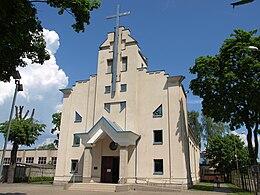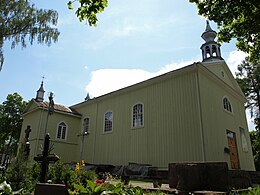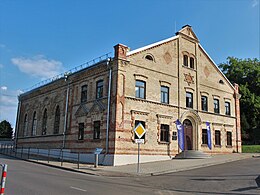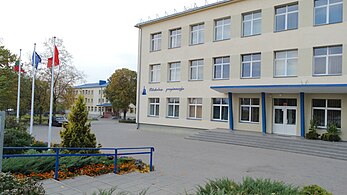Alytus
Alytus | |
|---|---|
Aerial view of Alytus Church of St. Louis Alytus College | |
|
| |
 Interactive map of Alytus | |
| Coordinates: 54°24′05″N 24°02′57″E / 54.40139°N 24.04917°E | |
| Country | |
| Region | Dzūkija |
| County | Alytus County |
| First mentioned | 1377 |
| City privileges | 1581 |
| Capital | Alytus |
| Government | |
| • Type | City Council |
| • Body | Alytus City Council |
| • Mayor | Nerijus Cesiulis (LSDP) |
| • Leading | Social Democratic Party[1] 20 / 27
|
| Area | |
• Total | 40 km2 (20 sq mi) |
| • Rank | 60th |
| Elevation | 200 m (700 ft) |
| Population (2024[2]) | |
• Total | 50,996 |
| • Rank | 6th |
| • Density | 1,300/km2 (3,300/sq mi) |
| • Rank | 5th |
| Demonym(s) | Alytian(s) (English) alytiškiai (Lithuanian) |
| Time zone | UTC+2 (EET) |
| • Summer (DST) | UTC+3 (EEST) |
| ZIP Codes | 62001–64355 |
| Phone code | +370 (315) |
| Website | alytus |
Alytus (Lithuanian: [ɐlʲiːˈtʊs] ⓘ) is a city with municipal rights in southern Lithuania.[3] It is also the capital of Alytus County.[3] Being the historical centre of the Dzūkija region, it is connected to several major roads, linking it with the cities of Vilnius; Kaunas; Lazdijai, which is on the border with Poland; and Grodno, Belarus.[3] In July 2024, its total population was counted as 50,996 people. The city lies on the banks of the Nemunas river.[3]
For centuries, the city was divided into two separate entities. Even today, it consists of two parts still frequently referred to as Alytus I and Alytus II. The Alytus I half is smaller, and less developed than the Alytus II half, which forms the city centre with parks, microdistricts and industrial areas.[4]
Name
[edit]The name of the city is believed to be derived from the Lithuanian hydronym Alytupis (meaning river).[5] Its name in other languages includes the Polish Olita,[a][6] the German Aliten, the RussianOlita,[b] the Belarusian Alita,[c] and the Yiddish Alite.[d]
History
[edit]




The first historical record of Alytus dates back to 1377,[7] when it was mentioned in the Chronicles of Wigand of Marburg under the name of Aliten.[8][9] According to the chronicle the spot was occupied by a small, wooden fortress guarding the Lithuanian frontier with the Teutonic Order. The fort and the surrounding village gradually grew, despite being frequently a target of raids of both the Lithuanians and the Teutons. The Treaty of Lake Melno left the town on the Teutonic side of the border, but it was retaken soon afterwards. On 15 June 1581 Grand Duke of Lithuania and King of Poland Stefan Batory granted the town the city rights based on the Magdeburg Law. The event is celebrated as the Alytus Day.
Until the Partitions of the Polish–Lithuanian Commonwealth the town was a part of the Trakai Voivodeship of the Grand Duchy of Lithuania and a notable center of commerce on the Nemunas river, serving as the main route for export goods from Lithuania proper. The town was also important as the place where one of the royal economic offices was located. In the third partition of Poland and Lithuania, in 1795, the town was divided between the Russian Empire and the Kingdom of Prussia. During the Napoleonic Wars, following the Treaty of Tilsit, the western part was ceded to the Duchy of Warsaw. After the Congress of Vienna it became part of the duchy's successor state, the Kingdom of Poland. Although the state was tied with a personal union with Russia, both parts of the town remained completely separate until the January Uprising of 1863. After that date, the autonomy of Poland was liquidated, but both parts of the town remained governed separately.
In the late 19th century the town was incorporated into a chain of Russian fortified garrisons along the border with East Prussia. It was tied with the rest of the world by a railway and a new road. In addition, the tsarist authorities constructed several barracks and an Eastern Orthodox church (in modern times converted to a Catholic church). However, despite the fortification effort by the Russians, during World War I the Central Powers managed to capture the town intact, without any major skirmish. In 1915 the town was incorporated into the so-called Ober Ost and both parts were once again united into a single administrative entity for the first time since 1795.
Following the end of World War I the area remained contested by newly independent Poland and Lithuania, with the actual control held by the German army stationed in the area. When the Germans withdrew in early 1919, the town was seized by the Red Army. On 12 February 1919, the town became a battlefield for the first skirmish between the Russians and the Lithuanian forces, which eventually took control over it. Since then the town has been a part of the Republic of Lithuania.
Following the invasion of Poland a large prisoner of war camp for Polish soldiers was established in the city. During World War II, Alytus was under German occupation from 22 June 1941 until 15 July 1944.[10] Following the German occupation of the city in 1941, the camp was converted into a prison camp for Soviet soldiers (Stalag 343). The 1965 Soviet-era book Masinės žudynės Lietuvoje, 1941–1944 lists two major mass graves in Alytus: Vidzgiris forest, then at the southeastern suburbs on the left bank of the river, estimated 60,000 people, most likely Jews from the eastern Soviet Union, and the Alytus forest, then at the eastern suburbs, estimated 35,000 people, most probably Soviet prisoners of war.[11] Historian Gintaras Lučinskas argues that these numbers were politicized and grossly inflated, and the actual number of victims is in single digits of thousands.[12][13][14]
In 2015, a HVDC back-to-back station for the realization of a power interconnection between Poland and Lithuania (LitPol) was inaugurated west of Alytus. The facility built by ABB has a transmission capacity of 500 MW at a voltage of ±70 kV.
The coat of arms features a white rose, one of two coat of arms in the country that features roses. "The bridge of White Rose" is the country's largest pedestrian bridge, whose name was chosen by the citizens. The bridge was built on the remains of a railway bridge, which was blown up by the Russians when they were retreating back in 1915.
Climate
[edit]Alytus has a humid continental climate with quite large seasonal differences.[15]
| Climate data for Alytus | |||||||||||||
|---|---|---|---|---|---|---|---|---|---|---|---|---|---|
| Month | Jan | Feb | Mar | Apr | May | Jun | Jul | Aug | Sep | Oct | Nov | Dec | Year |
| Mean daily maximum °C (°F) | −2.2 (28.0) |
−1.1 (30.0) |
3.9 (39.0) |
11.1 (52.0) |
18.3 (64.9) |
21.1 (70.0) |
22.2 (72.0) |
22.2 (72.0) |
16.7 (62.1) |
11.1 (52.0) |
4.4 (39.9) |
−0.6 (30.9) |
10.6 (51.1) |
| Daily mean °C (°F) | −5.0 (23.0) |
−4.4 (24.1) |
0.0 (32.0) |
6.1 (43.0) |
12.2 (54.0) |
15.6 (60.1) |
16.7 (62.1) |
16.7 (62.1) |
12.2 (54.0) |
7.2 (45.0) |
2.2 (36.0) |
−2.8 (27.0) |
6.4 (43.5) |
| Mean daily minimum °C (°F) | −7.8 (18.0) |
−7.8 (18.0) |
−3.9 (25.0) |
1.1 (34.0) |
6.1 (43.0) |
10.0 (50.0) |
11.7 (53.1) |
10.6 (51.1) |
7.2 (45.0) |
3.3 (37.9) |
0.0 (32.0) |
−5.0 (23.0) |
2.1 (35.8) |
| Average rainfall mm (inches) | 41 (1.6) |
27 (1.1) |
36 (1.4) |
41 (1.6) |
56 (2.2) |
74 (2.9) |
80 (3.1) |
70 (2.8) |
60 (2.4) |
48 (1.9) |
51 (2.0) |
50 (2.0) |
634 (25.0) |
| Average precipitation days | 8 | 9 | 14 | 16 | 16 | 12 | 13 | 14 | 12 | 14 | 8 | 7 | 143 |
| Source: [16] | |||||||||||||
Culture
[edit]
Alytus hosted the Art Strike Biennial between 18 and 24 August 2009 in response to Vilnius becoming European Capital of Culture for 2009. This included a demonstration[18] and a three sided football match.[19] The universal indoor Alytus Arena hosted the Eurobasket 2011 Group C matches in Alytus. In 2010, Alytus was awarded the Honourable Plate of the European Council.
Alytus has a museum dedicated to veterans of both the Afghan wars.
In Alytus, several Bonsai exhibitions were held with participants from European and other countries, such as Japan and the United States.
Alytus has hosted an annual Tomato tasting since 2007. Participants offer a wide variety of tomatoes and discuss the various factors which help produce a rich crop of the fruit.[20] Alytus has an industrial company named Snaigė, which manufactures refrigerators.[21]
Twin towns – sister cities
[edit] Amata, Latvia
Amata, Latvia Berdychiv, Ukraine
Berdychiv, Ukraine Botkyrka, Sweden
Botkyrka, Sweden Crawley, United Kingdom
Crawley, United Kingdom Ełk, Poland
Ełk, Poland General San Martín, Argentina
General San Martín, Argentina Giżycko County, Poland
Giżycko County, Poland Hiratsuka, Japan
Hiratsuka, Japan Kremenchuk, Ukraine
Kremenchuk, Ukraine Mandal, Norway
Mandal, Norway Næstved, Denmark
Næstved, Denmark Ningbo, China
Ningbo, China Opole, Poland
Opole, Poland Ostrołęka, Poland
Ostrołęka, Poland Rochester, United States
Rochester, United States Rouen, France
Rouen, France Suwałki, Poland
Suwałki, Poland Vélizy-Villacoublay, France
Vélizy-Villacoublay, France
The city was previously twinned with:[23]
 Grodno, Belarus
Grodno, Belarus Lida, Belarus
Lida, Belarus Petrozavodsk, Russia
Petrozavodsk, Russia Smarhonʹ, Belarus
Smarhonʹ, Belarus
Gallery
[edit]-
Saint Casimir Church
-
Church of the Guardian Angels
-
Alytus Synagogue
-
Saint Benedict Gymnasium
-
Piliakalnis Progymnasium
-
"Silent bell" memorial for the Lithuanian partisans
-
Commemoration of Nazi–Soviet Pact on 23 August 2013
-
School of Fine Crafts
-
Stage in the Valley of Songs
-
Alytus Tomato Tasting 2013
Crater of Mars
[edit]In 1979, one of craters in planet Mars was named 'Alitus' after the city of Alytus by the International Astronomical Union.[24]
Notes
[edit]References
[edit]- ^ "Titulinis - vrk.lt". www.vrk.lt.
- ^ "Resident population on 1 July". osp.stat.gov.lt. 19 July 2024.
- ^ a b c d Daugirdas, Vidmantas. "Alytus". Visuotinė lietuvių enciklopedija (in Lithuanian). Retrieved 25 November 2024.
- ^ Miškinis, Algimantas. "Alytaus architektūra". Visuotinė lietuvių enciklopedija (in Lithuanian). Retrieved 25 November 2024.
- ^ "Lietuvos miestų pavadinimų kilmė – tik upės ir pavardės?" [The origin of Lithuanian city names - only rivers and surnames?]. Delfi (in Lithuanian). 28 January 2012. Retrieved 29 September 2023.
- ^ Zych, Maciej; Kacprzak, Justyna, eds. (2019). Urzędowy wykaz polskich nazw geograficznych świata [Official List of Polish Geographical Names of the World] (in Polish) (2nd ed.). Warsaw: Główny Urząd Geodezji i Kartografii. p. 165. ISBN 978-83-254-2578-4.
- ^ "History of Alytus City". Alytus tourism information centre. Archived from the original on 28 June 2008. Retrieved 14 June 2008.
- ^ Miškinis, Algimantas. "Alytaus istorija". Visuotinė lietuvių enciklopedija (in Lithuanian). Retrieved 25 November 2024.
- ^ "Kokia seniausia Alytaus data ir kas toks yra Alštatas?". Alytausgidas.lt (in Lithuanian). 22 January 2023. Retrieved 25 November 2024.
- ^ "Освобождение городов". www.soldat.ru.
- ^ Masinės žudynės Lietuvoje, 1941-1944: dokumentų rinkinys (Mass Murders in Lithuania, 1941–1944: collection of documents), vol. 2, 1965, as cited by "The Jewish community of Alytus during World War II and afterwards (JewishGen article)". Archived from the original on 9 June 2009. Retrieved 24 March 2007.
- ^ Lučinskas, Gintaras, "Holokausto aukų skaičius Alytuje - sovietų pramanas?" ("The number of victims of the Holocaust in Alytus - a Soviet hoax?"), Terra Jatwezenorum, 2017, 9, 2, p. 63-85, 373-374, 351-352 (erticle content onlinee)
- ^ "Murder story of Alytus Jews in the Vidzgiris Forest", Yad Vashem
- ^ "Information Portal to European Sites of Remembrance". www.memorialmuseums.org.
- ^ "Alytus, Lithuania Climate Summary". Weatherbase. Retrieved 17 June 2015.
- ^ "Alytus, Lithuania Temperature Averages". weatherbase.com. Weatherbase. Retrieved 17 June 2015.
- ^ ""Jotvos vartai" kviečia į gyvosios istorijos festivalį Alytuje". Alytaus turizmo informacijos centras (in Lithuanian). Retrieved 10 November 2024.
- ^ 'Alytus -meno streiko sostine', Alytus Naujienos, Nr 15521st August 2009
- ^ Alytus art strike: 3-sided football (trišalis futbolas) accessed 30 August 2009
- ^ "POMIDORŲ DEGUSTACIJA". JŪSŲ DARŽUI. Retrieved 24 August 2013.
- ^ "Refrigerators | Freezers | A++ class refrigerators | SNAIGE".
- ^ "Tarptautinis bendradarbiavimas". alytus.lt (in Lithuanian). Alytaus miesto savivaldybė. Retrieved 21 January 2022.
- ^ "Alytus nutraukė bendradarbiavimą su Rusijos Federacijoje ir Baltarusijoje esančiais miestais partneriais". alytus.lt. 28 February 2022. Retrieved 17 March 2022.
- ^ "Alytus". Visuotinė lietuvių enciklopedija (in Lithuanian). Retrieved 25 November 2024.





















